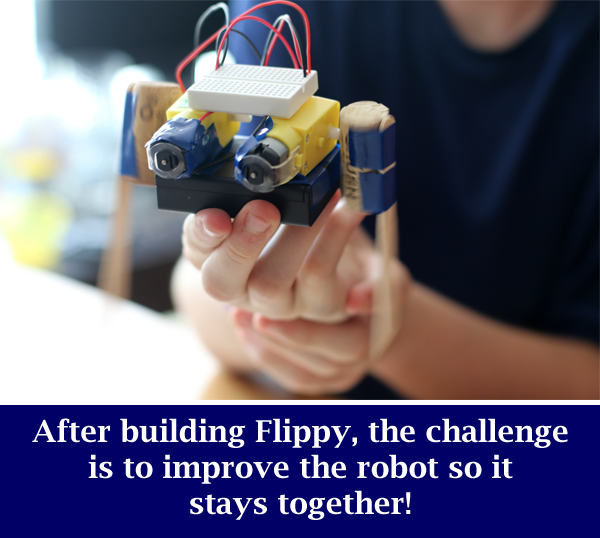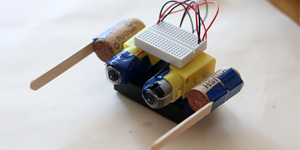Flippy the Robot Dances (and Falls Apart)
Engineering projects encourage students to think creatively, troubleshoot, and innovate. Sometimes there are no single "right" answers, and students will need to work, test, and brainstorm to find their own solutions to problems they encounter or to challenges presented. Building and improving a simple dancing robot whose legs fly off is a great way to "teach" lessons related to engineering and troubleshooting. Plus, Flippy is adorable, and this engineering challenge is a lot of fun!
When it comes to students and introductory robotics projects, every robot has its own personality. Turning toothbrush heads, scrub brushes, and even plastic cups into bots that skitter around is a lot of fun and invites students to add googly eyes and other personal touches to give their bots character. Building different kinds of introductory robots also helps students explore new science and engineering concepts and skills. A good road map of sequential robotics projects can lead to a wonderful series of additive hands-on learning experiments.
Robotics projects give students a chance to work with electronics and robotics principles, but these projects are also engineering projects. While step-by-step directions to do the "build" may be provided, students need to be taught how to deal with problems, how to troubleshoot when something doesn't work, and how to innovate and test new solutions. They need to learn to take these steps proactively and with confidence, and an engineering design project can help develop and reinforce these skills.
What happens when something doesn't go as expected? What happens when you are out of a material you need? What happens when the build is finished and it works but not well?
Robotics and engineering projects encourage students to think creatively, to troubleshoot, to innovate, and to test different solutions to address problems that arise from, or go beyond, the step-by-step directions. Flippy, the Dancing Robot is a great example of a robotics project that is, more importantly, specifically designed to provide a fun, hands-on exercise in thinking like an engineer.
A Dancing Robot
Building Flippy, the Dancing Robot is relatively simple, and the directions provided help students quickly put together a super cute robot that will dance around on a set of legs constructed from corks and popsicle sticks. (Note: Following the step-by-step, guided directions to assemble a circuit isn't, in and of itself, a science fair project. It is an exercise in following directions. In some cases, what happens "after" the build is what really matters.)
What most students will find is that as soon as they turn Flippy on, the corks fly off the motors.
This is exactly what is supposed to happen! Science Buddies scientists developed this project specifically to give students an engineering design challenge. That the legs fly off isn't a problem with the directions. It doesn't mean Flippy has been put together incorrectly. It means, instead, that once they see the legs fly off, students need to think like engineers and figure out how to tackle the problem at hand and improve upon the design so that Flippy can dance around without falling apart.
Building and improving Flippy puts the engineering design process in action. Students see a problem (the legs fly off) and then need to brainstorm solutions (what might work to help the legs stay on?) and then put these solutions to the test (let me try this) and see what happens. The legs may fly off again, and the process of troubleshooting, brainstorming, and testing starts over. Engineering design is often an iterative cycle of brainstorming, testing, observing results, and then doing these steps again.
Innovating and testing design changes to help Flippy stay together when he starts dancing is the point of a project like Flippy, the Dancing Robot. Building the robot itself is fun, but the initial build is not an experiment in which variables are being changed and tested. With Flippy, the learning happens when students think through the challenge Flippy poses and then set to work figuring out ways to make Flippy even better.
Flippy as a Model for Troubleshooting
When building a robot like Flippy, things can go wrong. Students who learn to troubleshoot and, where necessary, innovate, are much more confident when tackling new projects. Learning that they can think beyond the directions is empowering and an important skill within science, technology, engineering, and math (STEM) education. Here are some sample scenarios that might arise building something like Flippy:
- What happens if you don't have the foam tape that the project uses? Is there anything you could try that you do have?
- What happens if when you open up your motors, you find that they don't have leads attached like the ones in the directions? What options do you have?
- Can you test the motors before you build the whole robot to make sure they work? Why might this be helpful?
- What happens if you get all the way done and Flippy doesn't turn on? What can you check, double-check, or try?
- What different ways could you try to get the holes in the cork?
Flippy as a Model for Engineering Design
In addition to giving students room to troubleshoot basic problems, the Flippy project intentionally raises a number of opportunities for creative thinking and problem solving. The ultimate goal of this project is to figure out how to make Flippy stay together as he dances. After the basic build is complete, and the motors spin as they should (indicating the circuit is correct), students will pretty quickly see that Flippy has a problem.
The following questions are ones to consider with students:
- When does Flippy break?
- Does Flippy break the same (or at the same rate) when you hold it in the air as when it is sitting on a surface? Why or why not?
- Does Flippy behave the same on different types of surfaces?
- What materials might you use to help hold the legs on?
- What might happen as a result of trying to hold the legs in place with certain materials?
- Is the problem the size of the hole in the cork or something else?
- Does the length of the leg sticks matter?
- Would a different kind of material for the legs be better?
- Would a different configuration of the legs improve stability?
- The robot is designed so that the motors spin in opposite directions. Why?
- What happens if you reverse the motors so they spin the same way?
- What is the relationship of speed of the robot and its performance or stability?
- How could you slow down (or speed up) the robot's movements?
As students make changes and try new designs and improvements, be sure they are doing comparative trials and taking notes on what happens. One thing to look at with each new test is how long does Flippy dance before it breaks?

After building Flippy, the challenge is to improve the robot so it stays together!
Other Robotics and Creative Engineering Projects
Students interested in Flippy, the Dancing Robot may also be interested in other Science Buddies robotics projects and kits, including:
- Art Bot: Build a Wobbly Robot Friend That Creates Art
- Racing Bristlebots: On Your Mark. Get Set. Go!
- Build a Brushbot
- Build a Light-Tracking Bristlebot
- Build a Solar-Powered Bristlebot
- Build a Motion-Activated Guard Robot (BlueBot Project #1)
- Build a Speedy Light-Tracking Robot (BlueBot Project #2)
- Build a Zippy Line-following Robot (BlueBot Project #3)
- Build an Obstacle-Avoiding Robot (BlueBot Project #4)
For other creative electronics and engineering projects for students, see:
- Creative Paper Circuits with Copper Tape
- Wearable Electronics: Sewing an LED Patch
- Sewing Electronics: Wearables that Light Up
- Electronics and Play Dough: Fun, Tactile Family Science
- Building a Solar-powered Bristlebot
- Paper Circuits: Make Electrifying Art
- Electric Paint: Light Up Your Painting
- Electric Play Dough Project 1: Make Your Play Dough Light Up, Buzz, & Move!
- Electric Play Dough Project 2: Rig Your Creations With Lots of Lights!
- Electric Play Dough Project 3: Light Up Your Sculptures!
- LED Dance Glove: Get the Party Started with Your Own Interactive Light Show
- Make Music in Your Kitchen
- How Steady Are Your Hands?
- Digital Puppet
- Starry Night: Art that Changes in the Dark
- Explore Optical Illusions: Build an Infinity Mirror
See also: How to Do Robotics at Home with Your Kids
Note: while Flippy, the Dancing Robot does not require all of the specialty items that come in the BlueBot kit, it can be built using parts from the kit.
Categories:
You Might Also Enjoy These Related Posts:
- Plastics and Earth Day - Science Projects
- Arduino Science Projects and Physical Computing
- 10+ Robotics Projects with the BlueBot Kit
- 5 STEM Activities with Marshmallow Peeps
- March Madness Basketball Science Projects: Sports Science Experiments
- Women in STEM! More than 60 Scientists and Engineers for Women's History Month
- Explore Artificial Intelligence and Machine Learning with Student AI Projects
- 10 Reasons to Do the Rubber Band Car Engineering Challenge











